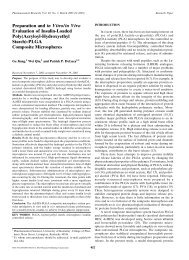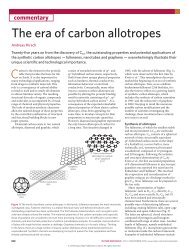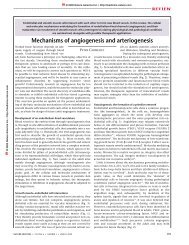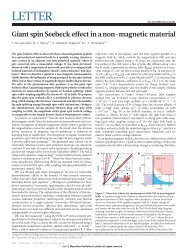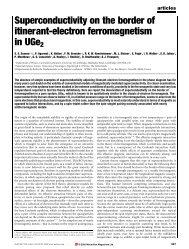Multi-hierarchical self-assembly of a collagen mimetic peptide from ...
Multi-hierarchical self-assembly of a collagen mimetic peptide from ...
Multi-hierarchical self-assembly of a collagen mimetic peptide from ...
You also want an ePaper? Increase the reach of your titles
YUMPU automatically turns print PDFs into web optimized ePapers that Google loves.
ARTICLES<br />
a<br />
PKGPKGPKGPKGPOGPOGPOGPOGDOGDOGDOGDOG<br />
PKGPKGPKGPKGPOGPOGPOGPOGDOGDOGDOGDOG<br />
PKGPKGPKGPKGPOGPOGPOGPOGDOGDOGDOGDOG<br />
POGPOGPOGDOGDOGDOGDOGPKGPKGPKGPKGPOGPOGPOGPOGDOGDOGDOGDOG<br />
GPKGPKGPKGPKGPOGPOGPOGPOGDOGDOGDOGDOGPKGPKGPKGPKGPOGPOGPO<br />
OGPOGDOGDOGDOGDOGPKGPKGPKGPKGPOGPOGPOGPOGDOGDOGDOGDOGPKGP<br />
b<br />
c<br />
Fibre growth<br />
rates: samples <strong>of</strong> both types <strong>of</strong> hydrogels treated with <strong>collagen</strong>ase<br />
dissolved fully after one hour (37 8C) or four hours (30 8C and<br />
room temperature), whereas untreated controls did not.<br />
Fibre diffraction. To learn more about the packing morphology <strong>of</strong><br />
the <strong>self</strong>-assembled nan<strong>of</strong>ibres and, in turn, the fibre <strong>self</strong>-<strong>assembly</strong><br />
process (Fig. 6), X-ray fibre diffraction studies were carried out on<br />
a dried <strong>peptide</strong> sample (see Methods). As is apparent <strong>from</strong> the<br />
microscopy images (Fig. 4), neighbouring fibres lack a common<br />
orientation axis. To align the fibres partially, the drying <strong>peptide</strong><br />
solution was placed in a strong magnetic field to promote<br />
alignment during the drying process. This methodology has been<br />
shown to produce highly aligned protein fibres 43 , but had only<br />
limited success in our system. Figure 6d shows the recorded<br />
diffraction pattern. The dried pellet exhibits some alignment, as<br />
evidenced by the pseudo two-fold symmetry observed in the<br />
intensity versus azimuthal angle scan <strong>of</strong> the diffraction pattern<br />
(see Supplementary Information). However, no clear equatorial or<br />
e<br />
d<br />
2.8 Å<br />
4.3 Å<br />
11.5 Å<br />
2 4 6 8 10 12 14 16 18 20<br />
D spacing (Å)<br />
Figure 6 | Proposed mechanism <strong>of</strong> fibre <strong>self</strong>-<strong>assembly</strong>. a, Peptide sequence<br />
shown as single-letter amino acid code with P for proline, K for lysine, G for<br />
glycine, O for hydroxyproline and D for aspartate. The minimum repeating<br />
unit <strong>of</strong> the triple helical fibre has extensive ‘sticky’ ends. As additional<br />
<strong>peptide</strong>s (shaded grey) add to the minimum repeating unit, the percentage<br />
<strong>of</strong> amino acids that forms a high-quality triple helical structure increases<br />
rapidly. Positively charged lysine residues are in blue, negatively charged<br />
aspartates are in red and satisfied intrahelical electrostatic interactions are<br />
indicated by purple lassoes. Available interhelical charged-pair hydrogen<br />
bonds are shown by small arrows. b, Lysine–aspartate interaction between<br />
the i and i þ 3 amino acids <strong>of</strong> adjacent <strong>peptide</strong> strands. c, Quasihexagonal<br />
packing <strong>of</strong> growing fibres results in a bundle approximately 2 by 4 nm based<br />
on a triple helical cross-section <strong>of</strong> 1.2 nm. d,e, Fibre diffraction pattern (d)<br />
and its radially averaged intensity (e). Characteristic bands at 2.8 Å, 4.3 Å<br />
and 11.5 Å match well with previously reported fibre diffraction <strong>from</strong> natural<br />
<strong>collagen</strong>. a.u. ¼ arbitrary units.<br />
826<br />
Intensity (a.u.)<br />
NATURE CHEMISTRY DOI: 10.1038/NCHEM.1123<br />
meridional axis could be determined and thus the data were<br />
analysed by performing a radial integration <strong>of</strong> the diffraction<br />
pattern to yield a plot <strong>of</strong> the observed intensities as a function <strong>of</strong><br />
D spacing (Fig. 6e). The plot shows three distinct features: a<br />
weaker, sharp line near 2.8 Å, a diffuse intense reflection near<br />
4.3 Å and a strong well-defined band near 11.5 Å. The spacing <strong>of</strong><br />
the observed lines agrees well with that observed for <strong>collagen</strong><br />
<strong>from</strong> stretched kangaroo-tail tendons 44 . Based on this, we assigned<br />
the 11.5 Å band to the distance between two triple helices within<br />
the nan<strong>of</strong>ibres, the diffuse reflection at 4.3 Å to the distance<br />
between <strong>peptide</strong> chains inside a triple helix and the reflection at<br />
2.8 Å to the translation per triple helical triplet. This suggests that<br />
our <strong>collagen</strong>-like <strong>peptide</strong> fibres pack in a fashion similar to that <strong>of</strong><br />
natural <strong>collagen</strong>.<br />
Proposed mechanism <strong>of</strong> <strong>assembly</strong>. As mentioned above, the charge<br />
pairing <strong>of</strong> lysine and aspartate was shown previously to form direct<br />
electrostatic interactions in <strong>collagen</strong> <strong>mimetic</strong> <strong>peptide</strong>s 18 . Specifically,<br />
lysine’s side chain reaches in a C-terminal direction to make an<br />
intimate salt-bridge hydrogen bond with an aspartate on an<br />
adjacent lagging <strong>peptide</strong> <strong>of</strong>fset by three amino acids (Fig. 6b). Our<br />
<strong>peptide</strong> forms a homotrimer, so there is a potential for these<br />
charged amino-acid salt bridges to form between <strong>peptide</strong> strands<br />
and create an <strong>of</strong>fset, sticky-ended triple helix. Similar sticky-ended<br />
assemblies have been designed and reported, particularly for<br />
alpha-helical coiled coils 45,46 . Figure 6a shows the proposed<br />
repeating unit <strong>of</strong> <strong>peptide</strong> <strong>self</strong>-<strong>assembly</strong>. Lysine–aspartate<br />
interactions are highlighted with purple lassoes. This favourable<br />
interaction forces a dramatic sticky-ended triple helix in which<br />
only one-third <strong>of</strong> the possible lysine–aspartate pairs are satisfied.<br />
However, as additional <strong>peptide</strong>s are added to extend the triple<br />
helical system, the fraction <strong>of</strong> satisfied charge pairs increases. For<br />
example, adding just one more <strong>peptide</strong> increases the fraction <strong>of</strong><br />
satisfied charge pairs to one-half and an infinite-length triple<br />
helical fibre will have two-thirds <strong>of</strong> the salt-bridges satisfied<br />
through intrahelical interactions. In addition, for our <strong>collagen</strong><br />
<strong>mimetic</strong> system, fibre elongation satisfies a larger percentage <strong>of</strong><br />
inter<strong>peptide</strong> backbone hydrogen bonds donated <strong>from</strong> glycine,<br />
which are known to stabilize <strong>collagen</strong> triple helices 47–52 . In the<br />
three-<strong>peptide</strong> nucleation centre, only 50% <strong>of</strong> the glycine residues<br />
are capable <strong>of</strong> forming these inter<strong>peptide</strong> interactions; however, as<br />
the fibre grows, the percentage <strong>of</strong> glycines that participate in<br />
hydrogen bonds approaches 100%.<br />
As observed by TEM, SEM and AFM, the nan<strong>of</strong>ibres formed<br />
have dimensions greater than those <strong>of</strong> a single <strong>collagen</strong> triple<br />
helix. Therefore, several triple helices must bundle together to<br />
form the observed nan<strong>of</strong>ibres. This is supported by the fibre diffraction<br />
data, which clearly display the characteristic triple-helix<br />
packing band at 11.5 Å (Fig. 6d,e). The lysine and aspartate side<br />
chains not participating in intrahelix salt bridges (indicated by<br />
small arrows in Fig. 6a) are available for interhelix interactions,<br />
which promote helix bundling. In natural <strong>collagen</strong>, five helices are<br />
believed to pack in a quasihexagonal fashion to form fibrils that continue<br />
to assemble into mature fibres 1,2 . Based on the height and<br />
width for the (Pro-Lys-Gly) 4 (Pro-Hyp-Gly) 4 (Asp-Hyp-Gly) 4 nan<strong>of</strong>ibres<br />
measured by AFM and cryo-TEM, respectively, and a helixpacking<br />
distance <strong>from</strong> fibre diffraction, we hypothesize that our<br />
<strong>peptide</strong> system assembles in a similar fashion. Figure 6c illustrates<br />
this packing. The AFM-calculated nan<strong>of</strong>ibre height was 1.2+<br />
0.3 nm and the nan<strong>of</strong>ibre width observed by cryo-TEM was<br />
4–5 nm. Both <strong>of</strong> these measured values are within reason for our<br />
proposed quasihexagonal packing. However, for the fibre height<br />
the value measured by AFM appears to be significantly less than<br />
expected. There are several possible explanations for this. First, it<br />
is known that in AFM the measured heights <strong>of</strong> s<strong>of</strong>t organic<br />
materials are <strong>of</strong>ten less than expected because <strong>of</strong> flattening <strong>from</strong><br />
NATURE CHEMISTRY | VOL 3 | OCTOBER 2011 | www.nature.com/naturechemistry<br />
© 2011 Macmillan Publishers Limited. All rights reserved.



